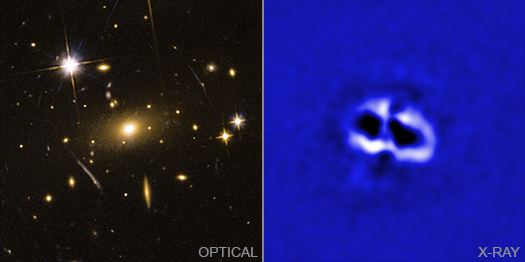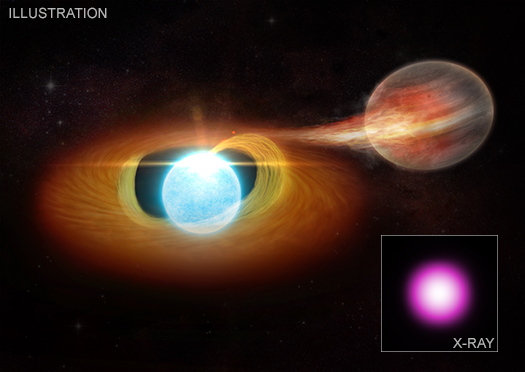An Expanse of Light

An Expanse of Light
Credit: X-ray: NASA/CXC/SAO; Optical: NASA/STScI, Palomar Observatory, DSS;
Radio: NSF/NRAO/VLA; H-Alpha: LCO/IMACS/MMTF
The recent launches of the James Webb Space Telescope (Webb) and the Imaging X-ray Polarimetry Explorer (IXPE) by NASA and its international partners are excellent reminders that the universe emits light or energy in many different forms. To fully investigate cosmic objects and phenomena, scientists need telescopes that can detect light across what is known as the electromagnetic spectrum.
This gallery provides examples of the ways that different types of light from telescopes on the ground and in space can be combined. The common thread in each of these selections is data from NASA's Chandra X-ray Observatory, illustrating how X-rays — which are emitted by very hot and energetic processes — are found throughout the Universe.
Eta Carinae: Visualization Explores A Massive Star's Great Eruption
Your browser does not support the video tag.
![]() More videos and information
More videos and information
Video Credit: J. Olmsted, D. Player, L. Hustak, A. Pagan, J. DePasquale, G. Bacon, F. Summers (STScI), R. Hurt (Caltech/IPAC), NASA, ESA; Music: "Sleepy Frieda", Maarten Schellekens, CC BY-NC 4.0; Image Credit: A. Fujii, J. Morse (BoldlyGo Inst), N. Smith (U Arizona), Hubble SM4 ERO Team, NASA, ESA, STScI, JPL-Caltech, CXC, ESO, NOAO, AURA, NSF
Eta Carinae, or Eta Car, is famous for a brilliant and unusual outburst, called the "Great Eruption", observed in the 1840s. This visualization presents the story of that event and examines the resulting multiwavelength emissions and three-dimensional structures surrounding Eta Car today.
Massive stars are known to have major outbursts. Eta Car, one of the most massive stars known, expelled about 10% of its mass in the Great Eruption, creating a small nebula, called the Homunculus Nebula, around it. Images taken in different wavelengths of light reveal different structures, each providing more information about the outbursts of Eta Car.
For this visualization, astronomers and artists have used NASA observations to model both the close-up and wide views of this massive and eruptive star. The Hubble Space Telescope and the Chandra X-ray Observatory have observed the nested layers of gas and dust around Eta Car using visible, ultraviolet, and X-ray light, as well as in the Hydrogen alpha emission line. The Spitzer Space Telescope provides a larger view of the Carina Nebula, along with Eta Car's dominant position within this star-forming region.
"Mini" Monster Black Hole Could Hold Clues to Giant's Growth
The graphic shows X-rays that NASA's Chandra X-ray Observatory detected from the dwarf galaxy Mrk 462. This X-ray emission (inset) is important because it reveals the presence of a growing supermassive black hole within this relatively small galaxy, as described in our latest press release. The mass contained in this black hole — about 200,000 times the mass of the Sun — provides information to astronomers about how some of the earliest black holes in the Universe may have formed and grown billions of years ago.
The background panel is an optical image from the Pan-STARRS telescope in Hawaii. There are several galaxies that are part of the HCG068 galaxy group on the left-hand side of the image. The galaxy that is emitting copious amounts of X-rays, however, is the much smaller galaxy located to the lower right of the image (marked by the arrow). Mrk 462 is a dwarf galaxy because it contains only a few hundred million stars, which means it holds about a hundred times fewer stars than a galaxy like the Milky Way. Black holes are notoriously hard to find in dwarf galaxies because they are usually too small and dim for optical light telescopes to track the rapid motions of stars in the centers.
Astronomers Spy Quartet of Cavities From Giant Black Holes

Galaxy Cluster RBS 797
Credit: X-ray: NASA/CXC/Univ. of Bologna/F. Ubertosi; Optical: NASA/STScl/M.Calzadilla
Four enormous cavities, or bubbles, have been found at the center of a galaxy cluster using NASA's Chandra X-ray Observatory, as described in our latest press release. The left panel of this graphic shows an optical image of the galaxy cluster called RBS 797, from NASA's Hubble Space Telescope. Hot gas that envelopes the individual galaxies is invisible in optical light, but it is detected in X-rays by Chandra (right). One pair of cavities can be seen towards the left and right of center in the Chandra image as black oval-shaped regions. The other pair is less distinct, but can be found above and below the center of the image.
Planetary Nebula: Misnamed But Not Misunderstood

Planetary Nebulas: NGC 6302, IC 418, NGC 3242, NGC 7662, NGC 7027, and NGC 2371.
Credit: X-ray: NASA/CXC/RIT/SAO/J.Kastner; Optical: NASA/ESA/AURA/STScI/Univ. Washington, B.Balick
Sometimes the names of objects are deeply misleading. For example, starfish are not actually fish (they are echinoderms) and guinea pigs are not related to pigs in any way (they are rodents). Similarly, planetary nebulas have nothing to do with planets. They were misnamed when scientists looking through small telescopes in the 19th century thought that these objects looked like planets.
Today, astronomers know that a planetary nebula actually represents a phase that stars like our Sun experience after they use up much of their fuel. After cooling and expanding through a “red giant” phase when it begins to expel its outer layers, such a star leaves behind a type of dense and smaller star called a white dwarf. The previously jettisoned shells of gas remain for a relatively short time in cosmic terms — tens of thousands of years — before dissipating into space. Meanwhile they are illuminated and energized by the white dwarf at the center of the system. This will happen to our Sun, but not for another 5 billion years or so.
Roasted and Shredded by a Stellar Sidekick

White Dwarf KPD 0005+5106
Credit: Illustration: NASA/CXC/M. Weiss; X-ray (Inset): NASA/CXC/ASIAA/Y.-H. Chu, et al.
A team of scientists used NASA's Chandra X-ray Observatory and ESA's XMM-Newton to investigate some unusual X-ray activity of a white dwarf star, as reported in our latest press release. The data suggest this white dwarf is blasting a companion object, which is either a low-mass star or planet, with waves of heat and radiation while pulling it apart through gravitational force.
Most stars, including the Sun, will become "white dwarfs" after they begin to run out of fuel, expand and cool into a red giant, and then lose their outer layers. This evolution leaves behind a stellar nub that slowly fades for billions of years. An artist's illustration shows a white dwarf as the blue-white sphere near the center.
From High School to a High-Energy Discovery

Julia Berndtsson
This blog post was written by Julia Berndtsson, a Swedish physics student currently in the third year of her undergraduate studies at Princeton University in the United States. For our latest Chandra result, she collaborated with Rosanne Di Stefano at the Center for Astrophysics | Harvard & Smithsonian during her last year of high school and through the first half of her freshman year at Princeton. She is currently exploring a range of topics in physics and engineering and works with Jason Petta's group at Princeton on developing semiconducting qubits.
When one imagines a scientist, a high school student usually isn’t the first thing that comes to mind. What people may or may not know is that there are multiple summer programs aimed at students still in their secondary education to gain exposure to research in their natural sciences, and it is because of such a program I ended up joining Dr. Rosanne Di Stefano in writing a paper on the discovery of the first planet candidate in an external galaxy.
The summer before my senior year, I was admitted to the Center for Excellence in Education’s Research Science Institute where participants were matched with a research mentor and given a project to be carried out over six weeks. Meeting Rosanne for the first time had me in awe. Not only did she give the students she took on her full confidence, but she would talk with excitement both about the topics that we were examining and over the fact that you were there to work on these problems too.
Behind the Story of the First Extragalactic Exoplanet Candidate

Rosanne DiStefano
We welcome Rosanne Di Stefano, an astrophysicist at the Center for Astrophysics | Harvard & Smithsonian, as our guest blogger. Her work has encompassed a broad range of astronomical systems: stars interacting within dense stellar environments, the binary evolution of possible progenitors of Type Ia supernovae, X-ray astronomy, and gravitational microlensing. In this post, she writes about her team’s finding of a possible planet candidate in M51, which is featured in our latest press release.
The discovery of a candidate planet in M51 (nicknamed the “Whirlpool” galaxy) represents several firsts. Perhaps most important, it is the first candidate planet in a distant galaxy. Since the 1750s, it has been conjectured that the dim distant nebulas, now called galaxies, are island universes: large, gravitationally-bound stellar populations similar to our home, the Milky Way. Since the work of Edwin Hubble in 1929, we have been able to study stars in other galaxies. Our discovery of the planet candidate — in a binary system called M51 ULS-1 — gives us the first peek into external populations of planetary systems, extending the reach of planet searches to distances roughly ten thousand times more distant.
The candidate planet is understood to be in the “circumbinary” orbit of a compact object (either a neutron star or a black hole) and a donor star, meaning that the donor and compact orbit one another and that the candidate planet orbits the mass center of these two. (We call it a “donor” star because the compact object is pulling material from its surface and into a disk around the neutron star or black hole.) This makes the planet candidate in M51 ULS-1 the first found to be orbiting a high-mass star. In our own Galaxy, astronomers have discovered more than 4800 planets, but the stars they orbit are less massive than about four times the mass of our own Sun. Stars can be very much more massive, however. While the exact value of the largest possible stellar mass in today’s Universe remains uncertain, it is at least 100 solar masses. The donor star in M51 ULS-1 appears to have the luminosity and spectrum of a 20 to 30 solar mass star.
When a Stable Star Explodes

Supernova Remnant G344.7-0.1
Credit: X-ray: NASA/CXC/Tokyo Univ. of Science/K. Fukushima, et al.; IR: NASA/JPL/Spitzer; Radio: CSIRO/ATNF/ATCA
White dwarfs are among the most stable of stars. Left on their own, these stars that have exhausted most of their nuclear fuel — while still typically as massive as the Sun — and shrunk to a relatively small size can last for billions or even trillions of years.
However, a white dwarf with a nearby companion star can become a cosmic powder keg. If the companion's orbit brings it too close, the white dwarf can pull material from it until the white dwarf grows so much that it becomes unstable and explodes. This kind of stellar blast is called a Type Ia supernova.
While it is generally accepted by astronomers that such encounters between white dwarfs and "normal" companion stars are one likely source of Type Ia supernova explosions, many details of the process are not well understood. One way to investigate the explosion mechanism is to look at the elements left behind by the supernova in its debris or ejecta.
Why Make Sonifications of Astronomical Data?

Jingle, Pluck, and Hum: Sounds from Space
Credit: NASA/CXC/SAO/K.Arcand, SYSTEM Sounds (M. Russo, A. Santaguida)
When you travel to a foreign country where they speak a language you do not understand, it is usually imperative that you find a way to translate what is being communicated to you. In some respects, the same can be said about data collected from objects in space.
A telescope like NASA's Chandra X-ray Observatory captures X-rays, which are invisible to the human eye, from sources across the cosmos. This high-energy light gets sent back down to Earth in the form of ones and zeroes. From there, the data are transformed into a variety of different things — from plots to spectra to images.
This last category — images — is arguably what most telescopes are best known for. For most of astronomy's long history, however, most who are blind or visually impaired (BVI) can often not fully experience the wonders that telescopes have captured.
In recent decades, that has begun to change. There are various ways that astronomers, data scientists, astronomy communication professionals, and others can work with communities of different abilities, from creating 3D prints and visual descriptions to sound-based products. As part of the Chandra X-ray Center and NASA's Universe of Learning, a team of experts led by Dr. Kimberly Arcand has been working to "sonify" (turn into sound) data from some of NASA's greatest telescopes.

